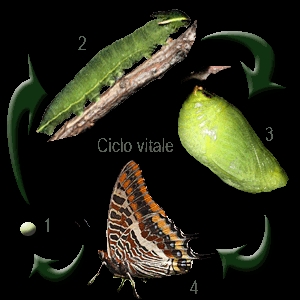The butterfly
 There are four main stages of a life cycle of a butterfly : egg, caterpillar, pupa and adult.
There are four main stages of a life cycle of a butterfly : egg, caterpillar, pupa and adult.
Egg: shortly before the time of hatching, the egg turns dark and the young caterpillar can be seen moving inside. First cut out a sort of "cover" circular drive in the casing of the egg, then pushes the body wriggling out of the egg.
This is one of the stages of greatest vulnerability. Once out, the caterpillar usually eats the empty shell of the egg. This provides the power needed to survive until the time when it will be able to identify its host plant.
Caterpillar: The caterpillar chooses a stem suitable and weaves a silk cushion, which attacks the tail. Then fixing a "belt" of the same material, which passes around the center of the body and which remains attached to the support offered by the stem. The cuticle of the caterpillar crack along the back and the pupa begins to emerge. A series of contortions pushes the cuticle of the caterpillar to the tail. This old skin is abandoned and a series of hooks of the tail is fastened to the bearing silky. At this point the pupa assumes its final shape.
Pupa: shortly before the flickering, the color of the adult butterfly becomes faintly visible. The shell of the pupa splits and the butterfly starts struggling to get out.
When it is fully out, the butterfly frm the end of the abdomen emits a liquid, called meconium, containing waste products accumulated during the pupal stage.
After hatching, the butterfly remains with the wings folded and hanging and expanded by pumping haemolymph into the wing veins. It is important that the wings of the insect not expand quickly enough before harden, otherwise, would remain permanently deformed.
Adult butterfly has a fully developed type of life totally different from that of the caterpillar: while it feeds on the leaves to grow, the butterfly spends his time sucking nectar of flowers and to mate.
In general, the life of a butterfly is quite short: it varies from a few days to a week or two, and only in some cases, can reach the month. For example, Vanessa io, or Eye of peacock, winters in hibernation before lay groups of more than 500 eggs at a time in early spring, so it is able to overcome two seasons.
The butterfly is the largest existing Ornithoptera alexandrae or Butterfly of Queen Alexandra, which can reach a wingspan of 31 cm, a body length of 8 cm and a weight of up to 12 grams.
The butterflies live on average a month, but some species die after only a few hours, while others skim the year. Monarch butterflies, which live between the U.S. and Mexico and perform migrations of thousands of miles, they can live from two weeks to eight months. In Costa Rica there are butterflies do not live more than two days, while Vanessa antiopa can get to touch the year. The longevity record belongs to a moth that feeds on a plant called Yucca baccata: its pupa can live up to 30 years before emerging as an adult.
This article was kindly provided by Damilano Valentino


 There are four main stages of a life cycle of a butterfly : egg, caterpillar, pupa and adult.
There are four main stages of a life cycle of a butterfly : egg, caterpillar, pupa and adult.
